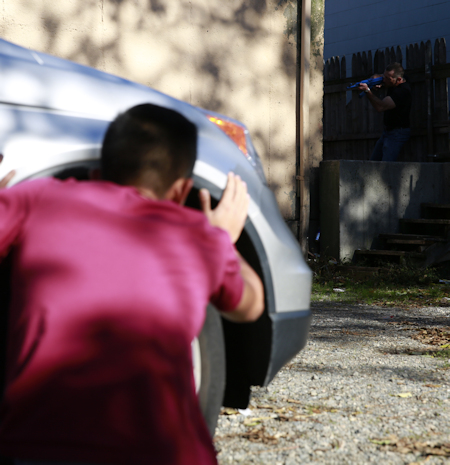About Rampage & Spree Killings
 An active shooter incident is one in which a gunman, is actively attempting to kill people in a populated location. The shooter’s goal is not to target just one specific
individual (though in a workplace shooting or similar, where an ex-employee wants to assassinate a supervisor/manager, this may be one of the desired outcomes), but to
kill as many people as they can. Active shooters are sometimes referred to as rampage killers, where they restrict themselves to one location and there is no “cooling off”
period between their killings – a serial killer may target single or multiple victims, but will have periods of “cooling off” time between each incident/victim(s); this
delay doesn’t exist in a rampage killing. Sometimes, a rampage occurs over multiple locations e.g. if a killer murders his family, goes to his place of work and commits
a series of killings there, and then goes to a town center or shopping mall, and starts shooting there, where there is little/no cooling off time between each incident,
these multiple shootings, will be classed as a spree killing. Some definitions of rampage and spree killings, require a certain number of dead and wounded, however it is
often more practical to use these terms in a broader sense.
An active shooter incident is one in which a gunman, is actively attempting to kill people in a populated location. The shooter’s goal is not to target just one specific
individual (though in a workplace shooting or similar, where an ex-employee wants to assassinate a supervisor/manager, this may be one of the desired outcomes), but to
kill as many people as they can. Active shooters are sometimes referred to as rampage killers, where they restrict themselves to one location and there is no “cooling off”
period between their killings – a serial killer may target single or multiple victims, but will have periods of “cooling off” time between each incident/victim(s); this
delay doesn’t exist in a rampage killing. Sometimes, a rampage occurs over multiple locations e.g. if a killer murders his family, goes to his place of work and commits
a series of killings there, and then goes to a town center or shopping mall, and starts shooting there, where there is little/no cooling off time between each incident,
these multiple shootings, will be classed as a spree killing. Some definitions of rampage and spree killings, require a certain number of dead and wounded, however it is
often more practical to use these terms in a broader sense.
Although mass killings usually involve firearms, they don’t have to. On November 11th 2016, a Somali student crashed his car into a group of pedestrians on the Columbus Campus of the Ohio State University, hitting 6. He then preceded to go on a rampage armed with a butcher’s knife injuring 5 more. Fortunately, nobody was killed, however 11 were injured (one critically). The incident ended when a Police Officer shot the suspect, Abdul Razak Ali Artan, killing him. In this rampage killing, no firearms were used, the weapons of choice were a car and a knife – this is why we prefer to use the term active killer, rather than active shooter; as our tactics and training are (and need to be) effective against individuals using a variety of weapons, not just firearms.
 The majority of active shooter/active killer incidents (60%) are over before law enforcement arrive, meaning that in most cases, the first responders to the event are those
at the scene being targeted. 57% of incidents end with with the shooter committing suicide, surrendering, or fleeing the scene. Of the 43% of situations where force is applied,
16% involve unarmed civilians engaging with the shooter/killer. It is possible for unarmed citizens to successfully engage and tackle an active shooter (though this should
always be seen as a last, rather than a first resort). In the 2011 Tucson shooting of Gabi Gifford, the shooter, Jared Lee Loughner, was hit over the head with a folding chair,
and tackled to the ground by a 74-year old man, as he tried to reload his Glock 19, and then subdued by several bystanders. On the 21st of August 2015, three men tackled an
active killer (using a knife, an AKM Assault Rifle and a 9mm Luger Pistol), on a train travelling from Amsterdam to Paris. One of them (Alex Scarlatos) realized that the
gunman’s weapon had jammed, and yelled “Get him!”, to the other two, who promptly charged the gunman (Ayoub El Khazzani) down. This is not the only occasion in which weapon
jams have created opportunities, both to evacuate, and to counter the shooter. On February 12th 2010, in a routine faculty meeting of the Biology Department of the
University of Alabama in Huntsville, Amy Bishop (who had just been denied tenure), stood up and started firing shots at fellow staff members; after several shots – at least 6 –
her gun jammed, and a member of staff initiated a rush, that saw several members of the group drive Bishop out of the room, and block the door. Amy Bishop was arrested a few
minutes later outside of the building, claiming the shooting had never happened. Despite how the movies depict firearms, they are machines with the propensity to go wrong.
The majority of active shooter/active killer incidents (60%) are over before law enforcement arrive, meaning that in most cases, the first responders to the event are those
at the scene being targeted. 57% of incidents end with with the shooter committing suicide, surrendering, or fleeing the scene. Of the 43% of situations where force is applied,
16% involve unarmed civilians engaging with the shooter/killer. It is possible for unarmed citizens to successfully engage and tackle an active shooter (though this should
always be seen as a last, rather than a first resort). In the 2011 Tucson shooting of Gabi Gifford, the shooter, Jared Lee Loughner, was hit over the head with a folding chair,
and tackled to the ground by a 74-year old man, as he tried to reload his Glock 19, and then subdued by several bystanders. On the 21st of August 2015, three men tackled an
active killer (using a knife, an AKM Assault Rifle and a 9mm Luger Pistol), on a train travelling from Amsterdam to Paris. One of them (Alex Scarlatos) realized that the
gunman’s weapon had jammed, and yelled “Get him!”, to the other two, who promptly charged the gunman (Ayoub El Khazzani) down. This is not the only occasion in which weapon
jams have created opportunities, both to evacuate, and to counter the shooter. On February 12th 2010, in a routine faculty meeting of the Biology Department of the
University of Alabama in Huntsville, Amy Bishop (who had just been denied tenure), stood up and started firing shots at fellow staff members; after several shots – at least 6 –
her gun jammed, and a member of staff initiated a rush, that saw several members of the group drive Bishop out of the room, and block the door. Amy Bishop was arrested a few
minutes later outside of the building, claiming the shooting had never happened. Despite how the movies depict firearms, they are machines with the propensity to go wrong.
In most active shooter/killer incidents, the majority of survivors, survive by evacuating the environment, rather than by tackling/countering the shooter (something that should only be attempted when all other options fail). Sometimes policies, such as the traditional school lockdown, instruct people not to evacuate, even when they have the chance e.g. in the Columbine School Shooting, those in the library were aware of a shooter(s) outside their room for 4 minutes and 10 seconds, before Harris and Klebold entered and started firing; there was another door through which they could have exited/evacuated before this happened, but both their teacher (Patti Neilsen), and the Police Dispatcher she was talking to, were following traditional lockdown procedures, and were telling everyone to stay down and hide under the desks. They were sitting ducks when Harris and Klebold finally entered. Active Shooter/Killer training should empower those in an incident to implement a variety of strategies and tactics that increase their survival chances, not restrict them to outdated and outmoded ideas.
If you would like to read more about the about the following, please click on the links below:
We have training packages and options for schools & colleges, business organizations, religious groups, and others. Please select the type of training you are interested in, from the services menu above.
Location
Krav Maga Yashir
165 New Boston St (Unit E)
Woburn, MA 01801
Active Shooter Boston Instructor
Gershon Ben Keren

Subscribe
Sign up with your email address to receive news and updates.